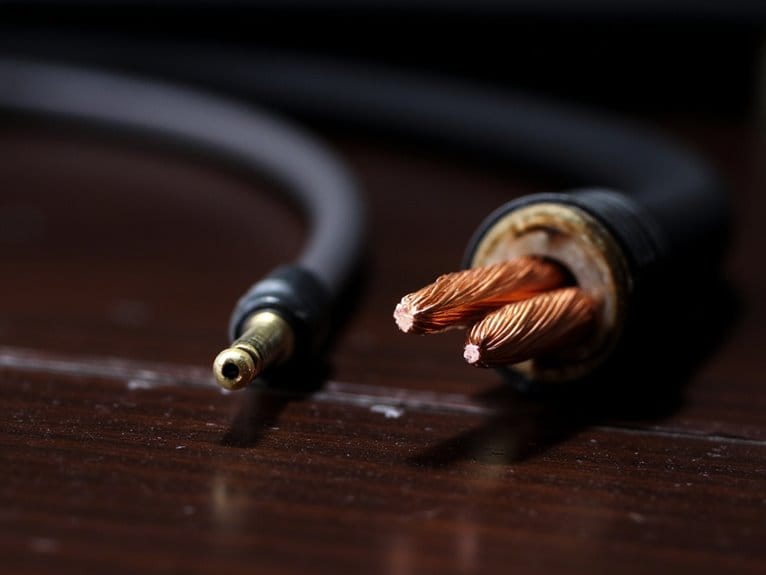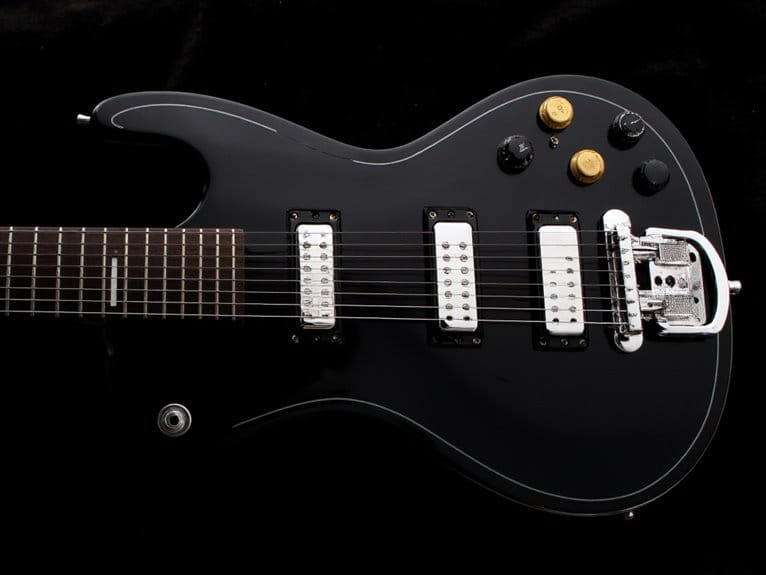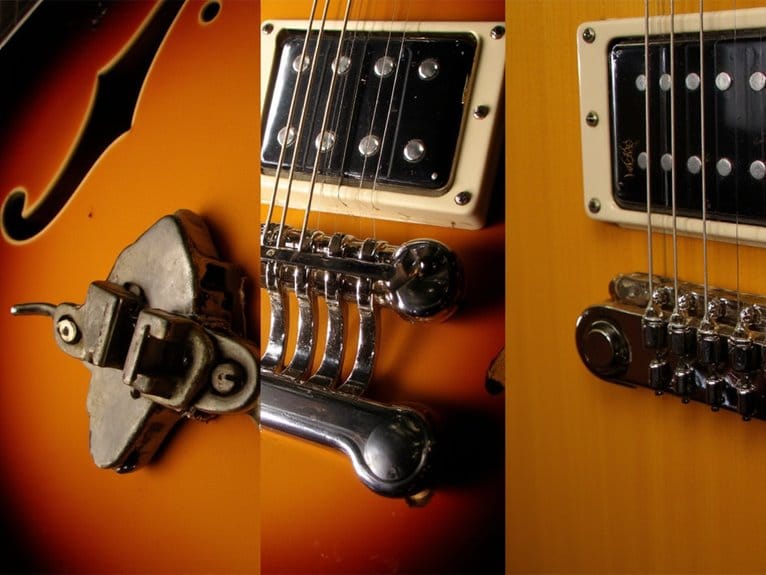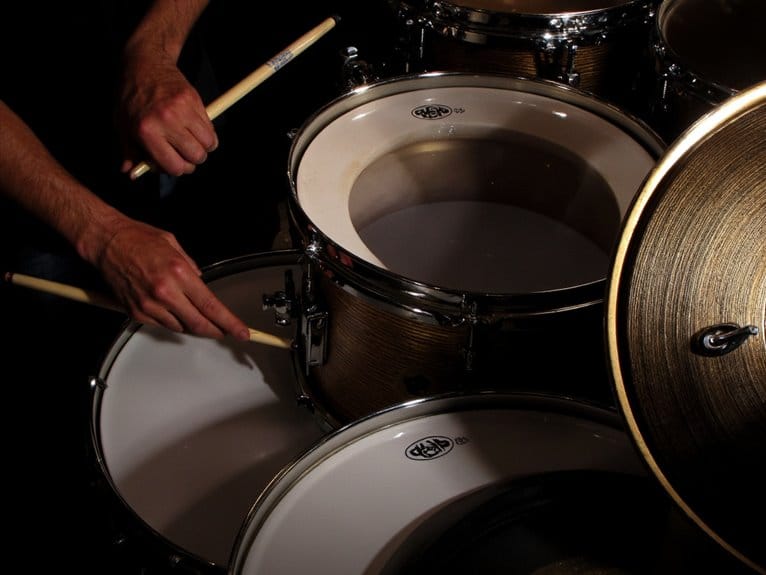Understanding Instrument Cables Vs Speaker Cables
You’ll find that instrument cables use coaxial construction with thin 20-24 gauge wire and shielding to carry high-impedance, low-voltage signals from your guitar pickups, while speaker cables feature thicker 12-14 gauge parallel conductors without shielding to handle high-current signals that drive voice coils. Using the wrong type risks equipment damage, since instrument cables can overheat with speaker-level current, and speaker cables introduce electromagnetic interference to delicate instrument signals. Understanding these distinctions guarantees you’ll avoid costly repairs and maintain peak sound quality.
We are supported by our audience. When you purchase through links on our site, we may earn an affiliate commission, at no extra cost for you. Learn more.
Notable Insights
- Instrument cables use coaxial construction with shielding for low-voltage signals, while speaker cables have two parallel conductors for high-power transmission.
- Speaker cables require thick 12-16 AWG wire to handle high current, whereas instrument cables use thin 20-26 AWG wire for flexibility.
- Instrument cables carry high-impedance signals from pickups; speaker cables handle low-impedance, high-current signals that drive voice coils in speakers.
- Using the wrong cable type can cause equipment damage, signal interference, overheating, and poor sound quality with hum and buzz.
- Connector types differ: instrument cables typically use 1/4″ TS plugs while speaker cables often employ Speakon or heavy-duty connectors.
Key Differences in Cable Construction and Design
While many musicians assume all audio cables serve the same purpose, I’ve learned through years of troubleshooting signal issues that instrument cables and speaker cables are engineered with fundamentally different designs to handle vastly different electrical requirements.
You’ll find instrument cables use coaxial construction with a single core conductor surrounded by protective shielding, typically foil wrap or braided mesh, which preserves signal integrity by blocking electromagnetic interference from your amp, pedals, and stage lights.
Speaker cables, however, feature two parallel conductors without shielding since they carry high-power signals that resist noise pickup naturally. This construction difference affects cable durability too—speaker cables use thicker 12-14 gauge wire for power handling, while instrument cables employ thinner 20-24 gauge conductors prioritizing flexibility over current capacity. For optimal audio performance, oxygen-free copper provides superior conductivity compared to standard copper-clad aluminum alternatives commonly found in budget speaker cables. Quality instrument cables feature 24K gold-plated connectors that resist corrosion and maintain reliable signal transmission over time. Longer instrument cables increase capacitance effects, which can muddy your tone and degrade signal clarity. Using the wrong cable type can result in equipment damage or significantly compromise your audio quality.
Signal Types and Electrical Characteristics
Beyond these physical construction differences, the electrical signals flowing through each cable type present distinct characteristics that determine how effectively your audio chain performs.
I’ve found that understanding these signal properties helps explain why swapping cable types creates immediate, often problematic results. Instrument cables carry high-impedance, low-voltage signals from your guitar’s pickups, transmitting continuous analog waveforms that represent string vibrations with remarkable precision when signal integrity remains intact.
Speaker cables handle completely different beasts—high-current, low-impedance signals at speaker level that drive voice coils through magnetic fields. Your instrument’s unbalanced signal path makes it vulnerable to interference over longer runs, while speaker cables’ robust current flow provides better noise reduction naturally. The speaker cable’s current flow follows Ohm’s Law, where the relationship between voltage, current, and resistance determines the power delivery to your drivers. Just as string gauge affects playability and tension on acoustic guitars, cable impedance matching influences signal transfer efficiency between components.
These fundamental electrical differences explain why proper cable matching becomes essential for maintaining clean audio transmission.
Wire Gauge and Current Handling Capabilities
The copper conductor running through the heart of your audio cable determines everything about current flow, and I’ve learned that wire gauge represents the single most critical specification separating instrument cables from speaker cables in real-world performance.
Your typical instrument cable uses thin 24-26 AWG wire that’s perfectly suited for low-current signals but would overheat instantly under speaker loads. Speaker cables demand thick 14-16 AWG conductors because they’re handling several amperes of current from your amplifier.
Wire thickness impact becomes obvious when you consider that thinner gauge creates higher resistance, wasting power as heat instead of delivering it to your speakers. Following proper cable safety standards isn’t just smart engineering—it prevents equipment damage and maintains ideal signal integrity.
Connector Types and Compatibility Features
Wire specifications mean nothing if you can’t connect your cables properly, and I’ve discovered that connector compatibility determines whether your audio setup works flawlessly or fails completely.
Instrument cables mainly use 1/4″ TS connectors for unbalanced signals, connecting guitars and basses to amplifiers without locking mechanisms, which honestly makes them prone to accidental disconnection during energetic performances.
Speaker cables employ robust Speakon connectors with twist-lock designs that prevent disconnection under high-vibration conditions, plus they handle the higher current loads that instrument connectors simply can’t manage safely.
Professional setups often feature XLR connectors with locking latches for balanced transmission, while TRS connectors bridge instrument and line-level applications.
Many audio interfaces include combination XLR/1/4″ inputs that accept both microphone and instrument connections, providing versatility for recording setups where phantom power can be selectively applied to microphone inputs without affecting instrument signals.
Understanding these connector types and compatibility features guarantees you’ll match the right cable to your specific application, avoiding equipment damage and performance issues.
Consequences of Using the Wrong Cable Type
When you grab the wrong cable type, you’re fundamentally setting yourself up for a cascade of problems that range from annoying background noise to potentially damaging your expensive equipment.
Using speaker cables for instrument connections introduces electromagnetic interference that corrupts your signal, while forcing instrument cables to handle speaker-level current creates overheating risks that can lead to equipment damage.
The consequences include:
- Degraded sound quality from increased hum, buzz, and radio frequency interference
- Amplifier stress from improper impedance matching and restricted current flow
- Cable overheating, signal loss, or fire hazards when wire gauge is inadequate
- Reduced speaker performance and volume output limitations
- Costly repairs and frequent troubleshooting during critical performances
I’ve seen musicians struggle through entire gigs because they couldn’t identify why their tone sounded terrible.
Frequently Asked Questions
Can I Make My Own Instrument or Speaker Cables at Home?
You can absolutely tackle DIY cable construction at home with basic soldering skills and proper tools. Cable material choices include shielded wire for instruments and thicker unshielded wire for speakers, plus appropriate connectors.
How Long Can Cables Be Before Signal Quality Starts Degrading?
Cable length affects signal degradation differently by type. You’ll notice instrument cables start degrading around 15-25 feet, while speaker cables can handle up to 50 feet before you experience noticeable signal quality loss.
Do Expensive Cables Really Sound Better Than Budget Options?
Expensive cables don’t guarantee better sound quality in your setup. Multiple tests show no substantial audible differences during normal use. You’re often paying for build quality and durability rather than meaningful price comparison improvements.
Can Wireless Systems Completely Replace Instrument Cables for Live Performances?
Wireless systems can’t completely replace instrument cables yet. You’ll enjoy wireless benefits like enhanced mobility and cleaner stages, but you’re risking battery failures and interference that could compromise sound quality during critical performances.
How Should I Properly Store and Maintain My Audio Cables?
You should use over-under wrapping techniques and store cables in dry, enclosed spaces for proper cable organization. Regular cleaning, testing, and visual inspections guarantee effective damage prevention and extend your cables’ lifespan considerably.
On a final note
You can’t afford to mix up these cable types if you’re serious about your audio setup. I’ve seen too many people fry their gear or wonder why their sound’s terrible because they grabbed the wrong cable. Remember, instrument cables carry low-level signals with higher impedance, while speaker cables handle high-current, low-impedance power transmission. Getting this wrong isn’t just inefficient—it’s potentially expensive.






